Early History of Coorow
The traditional owners of different parts of the present-day Shire of Coorow are the Amangu, Badymia and Yued language groups of Aboriginal people.
English born William Long settled in the Coorow district in 1862. He was accompanied by his wife Sarah, their three daughters, his mother Elizabeth and stepfather William Brand. They settled in the bush near a waterhole named Coorow Spring and slowly developed a large pastoral station. Their property was known as both Coorow Station and Long's Station.
Using mud from a dam and chopped up rushes, the Long family made mud bricks and used them to build themselves a house. Later in the 1860s they gained neighbours 26 kilometres to the north and 16 kilometres to the north-east with the establishment of Carnamah Station by Duncan Macpherson and Noolooloo Station by James Nairn.
In their first 15 years at Coorow, Mrs Sarah Long gave birth to another four children - two sons and two more daughters.
In 1891 the family had 8,000 sheep but very few fences. They employed a number of shepherds and it has been said that each shepherd looked after 1,000 sheep! In 1891 they also had 300 horses, 100 head of cattle, some pigs and grew 40 acres of crop. Wool from their sheep was carted to Dongara while their horses were sold in Guildford for export to India.
William Long expanded his enterprise in 1892 by securing a contract to deliver mail. The Midland Railway had reached Coorow in 1891 but remained unfinished between Coorow and Yandanooka. William transported both mail and people across the unfinished gap in the railway. The railway was comleted in 1894 with station at Coorow.
William Long died in 1899 and his Coorow Station was taken over by his sons Harry and Clem. During this time Harry had two children with Sarah Mabel Bell, an Aboriginal woman from Yalgoo. The station shrunk to a series of small blocks surrounding waterholes, which were sold to Frank Thomas Snr in 1902.
Frank Latham, who had worked for Harry and Clem Long, commenced farming at Marchagee (South Coorow) in 1903. He also explored the country east of Coorow, which had been regarded as No Man's Land. A rock waterhole and later a railway siding and town were named Latham in his honour. Frank married Aboriginal woman Mary Oliver from Gullewa, who was later affectionately known for many years in Coorow as Granny Latham.
Others to take up land and begin developing farms in the Coorow district during the 1900s and early 1910s were Western Australian born Hamlet Jones; Victorian born Samuel Rudduck and Angus McGilp; Irish born Henry Armstrong; South Australian born George Battersby, Tom Bonham, Fred Kau, Heinie Bothe, Charlie Bothe and Baxter Bothe; and Italian born Francis Vanzetti. After briefly leaving Coorow, brothers Harry and Clem Long returned and took up land, which was later farmed by their nephew Ernie Long.
In return for building the railway line, the Midland Railway Company had been granted over three million acres of land. This included a significant portion of Coorow and most of Waddy Forest (East Coorow). The company developed a number of "Ready-Made Farms" in Coorow, whch were each about 400 acres in size, partially cleared of virgin bush, fenced and contained a weatherboard house, rainwater tank and dam.
The first Ready-Made Farm sold in Coorow was purchased in 1911 by Philip Farley, a retired marine captain who immigrated from India to settle on his farm with his wife and children. Another three farms were sold soon-after to Australian born Rev. James Macdonald (a chaplain in India), Danish born Carl Jensen (a ship's captain in India) and Scottish born Robert Leslie (who had already immigrated to Western Australia).
In 1909 the government reserved land for a town on the western side of the railway adjoining the Coorow railway station. The reserve was gazetted a townsite "to be known and distinguished as Coorow" on 1 November 1912. The Midland Railway Company subsequently surveyed adjacent townsite blocks on the eastern side of the railway. The first development in what was to become the townsite were two general stores. The first had opened by 1911 and was run by Charles Matthews while the second was started in mid 1912 by Cowper Todd, who was also a farmer in Latham.
Ellen Farley, a teacher who had settled with her parents on a Ready-Made Farm, opened the Coorow State School in February 1912. It was initially run from a farm shed before shifting into a room of Coorow House (the homestead originally built by the Long family). The school frequently closed, reopened and moved locations.
At least 14 men from Coorow enlisted in the Australian Imperial Force and served abroad during the First World War. Local farmhands George Bell and Tom Carroll were both killed at the Gallipoli landings in 1915 and George's cousin Tom McGill died from wounds in France in 1917.
To assist soldiers returning from the war, Samuel Rudduck sold at a discounted price 2,391 acres of his farm at Marchagee to the government. The land was named Rudduck Estate and was split into two farms for solider settlement in 1919. One of the farms was taken up by Bertie Loveless, who had worked in the district before the war.
Further land in the eastern portion of the Coorow distict, at Waddy Forest, was opened up for purchase by the Midland Railway Company in 1921. Within a year nine men had taken up virgin land to develop into farms. They were South Australian born Don Fowler and brothers Phil and Will Morcombe; Western Australian born Bert Bateman and Malcolm Patton; Victorian born Donald McDonald; and English born Fred Roberts and brothers Guy and George Greenwood.
Food, saddles and the best of horses were stolen from farms, homes, trains and railway sidings. The thefts were the work of Frank Thomas Jnr, a local boy gone wrong who took to the life of a thieving bushranger. Frank was an accomplished rider and bushman who was capable of eluding police on their many attempts to capture him. Public opinion differed greatly, with some believing he was harshly targeted and blamed for more crimes than he had committed. He escaped from custody twice but was captured for the last time in 1922.
The development of roads in Coorow was the responsibility of the Upper Irwin Road Board at Mingenew until 1923 when the Carnamah District Road Board was established. Coorow had two seats on the new board, which were initially filled by local farmers Angus McGilp of Waddy Forest and Frank Bryant of Marchagee.
The first licensed vehicle in Coorow was an Essex car purchased by Charlie and Baxter Bothe in March 1923. It initially contained the number-plate MI•20 but switched to CA•25 following the change in Road Board. By mid 1928 there were 70 registered vehicles in the district.
In 1924 Gus Liebe began purchasing land at Waddy Forest. Gus was a German immigrant and had been a prominent builder in Perth before becoming a farmer at Wubin. Through many expansions he grew his Waddi Farm at Waddy Forest to a total of 53,357 acres. In 1929 he grew 100,000 bags of wheat, which at the time made him the largest individual farmer in the world. He later added sheep and peaked with a flock of 23,000 sheep producing an annual clip of 465 bales of wool.
An official school building was moved to the Coorow townsite in 1922 and in 1923 and 1929 the Waddy Forest and Waddy Well state schools were opened in the eastern part of the district. Community halls were built in Coorow in 1923, Waddy Forest in 1925 and East Marchagee in 1933. A recreation ground was cleared in Coorow in 1928 and was named Maley Park after Charlie Maley, a farmer in Three Springs who was also the local Member of the Legislative Assembly.
Considerable construction occurred in the Coorow townsite in the late 1920s including Bob Wells' bakery, butcher's shop and garage; shops for the North Midlands Farmers' Co-operative Company and Gerald & Lloyd Williams; and updated shops for Heinie Bothe and Lilian & Fred Bingham. 98 people from Coorow and Waddy Forest signed a petition in 1929 for a hotel license to be granted for Coorow. The hotel opened in 1930 under the management of Alex Gloster.
During the 1930s local organisations included the Coorow-Waddy Forest Districts Agricultural Society, the Coorow-Waddy Forest Progress Association, Coorow-Waddy branch of the Primary Producers Association, Waddy Forest Toc H Group and cricket, football, golf, rifle and tennis clubs.
During the Second World War the agricultural society repurposed itself into a Patriotic Funds Committee to contribute to the war effort; while local Volunteer Defence Corps and a branch of the Red Cross Society were established. Those to pay the ultimate sacrifice during the war included Coorow farmhand Spanner Spencer and cousins Keith and Jim Morcombe from Waddy Forest.
In 1946 Coorow-Waddy Forest branches were formed of both the Country Women's Association (C.W.A.) and the Farmers Union of Western Australia. In 1950 the War Service Land Settlement scheme purchased the late Gus Liebe's enormous property Waddi and subdivided it into 17 smaller farms, which were allocated to returned servicemen from the Second World War.
Related Content
● Biographical Dictionary of Coorow
● Virtual Museum - Midland Railway
● Virtual Museum - Ready-Made Farms
● Virtual Museum - Coorow Bushranger
● Blog Post - The Coorow Parrot
● 1937 Coorow-Waddy Show Schedule
● Virtual Museum - 1940s and 50s Toys
● 1948 Coorow-Waddy Show Schedule
● Coorow Heritage Group's Lost Coorow
● Coorow burials at the Winchester Cemetery
● Histories of Carnamah and Three Springs
About This History
This is an evolving history by Andrew Bowman-Bright, written between 2018 and 2022.
The traditional owners of different parts of the present-day Shire of Coorow are the Amangu, Badymia and Yued language groups of Aboriginal people.
English born William Long settled in the Coorow district in 1862. He was accompanied by his wife Sarah, their three daughters, his mother Elizabeth and stepfather William Brand. They settled in the bush near a waterhole named Coorow Spring and slowly developed a large pastoral station. Their property was known as both Coorow Station and Long's Station.
Using mud from a dam and chopped up rushes, the Long family made mud bricks and used them to build themselves a house. Later in the 1860s they gained neighbours 26 kilometres to the north and 16 kilometres to the north-east with the establishment of Carnamah Station by Duncan Macpherson and Noolooloo Station by James Nairn.
In their first 15 years at Coorow, Mrs Sarah Long gave birth to another four children - two sons and two more daughters.
In 1891 the family had 8,000 sheep but very few fences. They employed a number of shepherds and it has been said that each shepherd looked after 1,000 sheep! In 1891 they also had 300 horses, 100 head of cattle, some pigs and grew 40 acres of crop. Wool from their sheep was carted to Dongara while their horses were sold in Guildford for export to India.
William Long expanded his enterprise in 1892 by securing a contract to deliver mail. The Midland Railway had reached Coorow in 1891 but remained unfinished between Coorow and Yandanooka. William transported both mail and people across the unfinished gap in the railway. The railway was comleted in 1894 with station at Coorow.
William Long died in 1899 and his Coorow Station was taken over by his sons Harry and Clem. During this time Harry had two children with Sarah Mabel Bell, an Aboriginal woman from Yalgoo. The station shrunk to a series of small blocks surrounding waterholes, which were sold to Frank Thomas Snr in 1902.
Frank Latham, who had worked for Harry and Clem Long, commenced farming at Marchagee (South Coorow) in 1903. He also explored the country east of Coorow, which had been regarded as No Man's Land. A rock waterhole and later a railway siding and town were named Latham in his honour. Frank married Aboriginal woman Mary Oliver from Gullewa, who was later affectionately known for many years in Coorow as Granny Latham.
Others to take up land and begin developing farms in the Coorow district during the 1900s and early 1910s were Western Australian born Hamlet Jones; Victorian born Samuel Rudduck and Angus McGilp; Irish born Henry Armstrong; South Australian born George Battersby, Tom Bonham, Fred Kau, Heinie Bothe, Charlie Bothe and Baxter Bothe; and Italian born Francis Vanzetti. After briefly leaving Coorow, brothers Harry and Clem Long returned and took up land, which was later farmed by their nephew Ernie Long.
In return for building the railway line, the Midland Railway Company had been granted over three million acres of land. This included a significant portion of Coorow and most of Waddy Forest (East Coorow). The company developed a number of "Ready-Made Farms" in Coorow, whch were each about 400 acres in size, partially cleared of virgin bush, fenced and contained a weatherboard house, rainwater tank and dam.
The first Ready-Made Farm sold in Coorow was purchased in 1911 by Philip Farley, a retired marine captain who immigrated from India to settle on his farm with his wife and children. Another three farms were sold soon-after to Australian born Rev. James Macdonald (a chaplain in India), Danish born Carl Jensen (a ship's captain in India) and Scottish born Robert Leslie (who had already immigrated to Western Australia).
In 1909 the government reserved land for a town on the western side of the railway adjoining the Coorow railway station. The reserve was gazetted a townsite "to be known and distinguished as Coorow" on 1 November 1912. The Midland Railway Company subsequently surveyed adjacent townsite blocks on the eastern side of the railway. The first development in what was to become the townsite were two general stores. The first had opened by 1911 and was run by Charles Matthews while the second was started in mid 1912 by Cowper Todd, who was also a farmer in Latham.
Ellen Farley, a teacher who had settled with her parents on a Ready-Made Farm, opened the Coorow State School in February 1912. It was initially run from a farm shed before shifting into a room of Coorow House (the homestead originally built by the Long family). The school frequently closed, reopened and moved locations.
At least 14 men from Coorow enlisted in the Australian Imperial Force and served abroad during the First World War. Local farmhands George Bell and Tom Carroll were both killed at the Gallipoli landings in 1915 and George's cousin Tom McGill died from wounds in France in 1917.
To assist soldiers returning from the war, Samuel Rudduck sold at a discounted price 2,391 acres of his farm at Marchagee to the government. The land was named Rudduck Estate and was split into two farms for solider settlement in 1919. One of the farms was taken up by Bertie Loveless, who had worked in the district before the war.
Further land in the eastern portion of the Coorow distict, at Waddy Forest, was opened up for purchase by the Midland Railway Company in 1921. Within a year nine men had taken up virgin land to develop into farms. They were South Australian born Don Fowler and brothers Phil and Will Morcombe; Western Australian born Bert Bateman and Malcolm Patton; Victorian born Donald McDonald; and English born Fred Roberts and brothers Guy and George Greenwood.
Food, saddles and the best of horses were stolen from farms, homes, trains and railway sidings. The thefts were the work of Frank Thomas Jnr, a local boy gone wrong who took to the life of a thieving bushranger. Frank was an accomplished rider and bushman who was capable of eluding police on their many attempts to capture him. Public opinion differed greatly, with some believing he was harshly targeted and blamed for more crimes than he had committed. He escaped from custody twice but was captured for the last time in 1922.
The development of roads in Coorow was the responsibility of the Upper Irwin Road Board at Mingenew until 1923 when the Carnamah District Road Board was established. Coorow had two seats on the new board, which were initially filled by local farmers Angus McGilp of Waddy Forest and Frank Bryant of Marchagee.
The first licensed vehicle in Coorow was an Essex car purchased by Charlie and Baxter Bothe in March 1923. It initially contained the number-plate MI•20 but switched to CA•25 following the change in Road Board. By mid 1928 there were 70 registered vehicles in the district.
In 1924 Gus Liebe began purchasing land at Waddy Forest. Gus was a German immigrant and had been a prominent builder in Perth before becoming a farmer at Wubin. Through many expansions he grew his Waddi Farm at Waddy Forest to a total of 53,357 acres. In 1929 he grew 100,000 bags of wheat, which at the time made him the largest individual farmer in the world. He later added sheep and peaked with a flock of 23,000 sheep producing an annual clip of 465 bales of wool.
An official school building was moved to the Coorow townsite in 1922 and in 1923 and 1929 the Waddy Forest and Waddy Well state schools were opened in the eastern part of the district. Community halls were built in Coorow in 1923, Waddy Forest in 1925 and East Marchagee in 1933. A recreation ground was cleared in Coorow in 1928 and was named Maley Park after Charlie Maley, a farmer in Three Springs who was also the local Member of the Legislative Assembly.
Considerable construction occurred in the Coorow townsite in the late 1920s including Bob Wells' bakery, butcher's shop and garage; shops for the North Midlands Farmers' Co-operative Company and Gerald & Lloyd Williams; and updated shops for Heinie Bothe and Lilian & Fred Bingham. 98 people from Coorow and Waddy Forest signed a petition in 1929 for a hotel license to be granted for Coorow. The hotel opened in 1930 under the management of Alex Gloster.
During the 1930s local organisations included the Coorow-Waddy Forest Districts Agricultural Society, the Coorow-Waddy Forest Progress Association, Coorow-Waddy branch of the Primary Producers Association, Waddy Forest Toc H Group and cricket, football, golf, rifle and tennis clubs.
During the Second World War the agricultural society repurposed itself into a Patriotic Funds Committee to contribute to the war effort; while local Volunteer Defence Corps and a branch of the Red Cross Society were established. Those to pay the ultimate sacrifice during the war included Coorow farmhand Spanner Spencer and cousins Keith and Jim Morcombe from Waddy Forest.
In 1946 Coorow-Waddy Forest branches were formed of both the Country Women's Association (C.W.A.) and the Farmers Union of Western Australia. In 1950 the War Service Land Settlement scheme purchased the late Gus Liebe's enormous property Waddi and subdivided it into 17 smaller farms, which were allocated to returned servicemen from the Second World War.
Related Content
● Biographical Dictionary of Coorow
● Virtual Museum - Midland Railway
● Virtual Museum - Ready-Made Farms
● Virtual Museum - Coorow Bushranger
● Blog Post - The Coorow Parrot
● 1937 Coorow-Waddy Show Schedule
● Virtual Museum - 1940s and 50s Toys
● 1948 Coorow-Waddy Show Schedule
● Coorow Heritage Group's Lost Coorow
● Coorow burials at the Winchester Cemetery
● Histories of Carnamah and Three Springs
About This History
This is an evolving history by Andrew Bowman-Bright, written between 2018 and 2022.
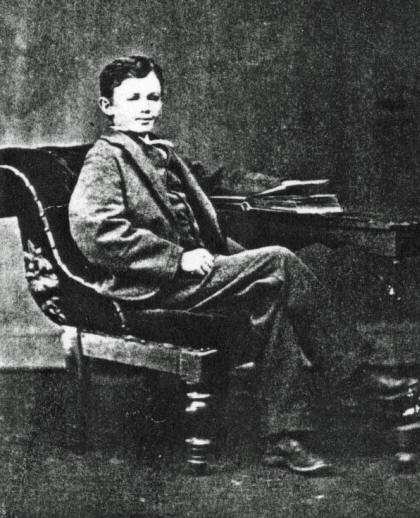
Harry, son of William and Sarah Long,
who was born in Coorow in 1865
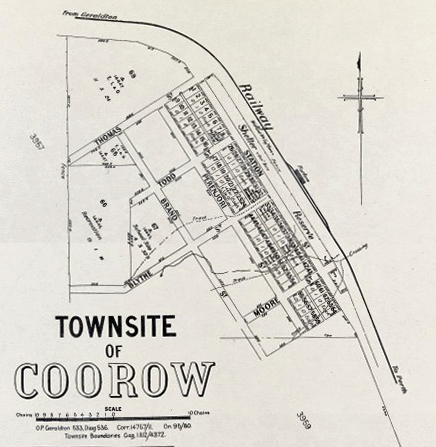
1912 map of the government's Coorow townsite
on the western side of the railway
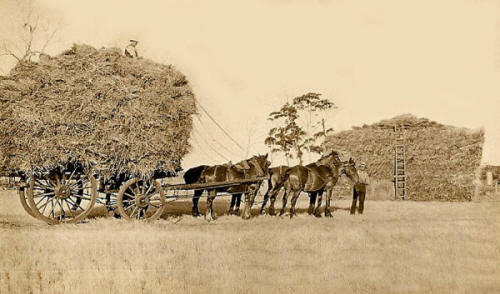
Cating Hay on Bothe's Inglewood Farm in Coorow
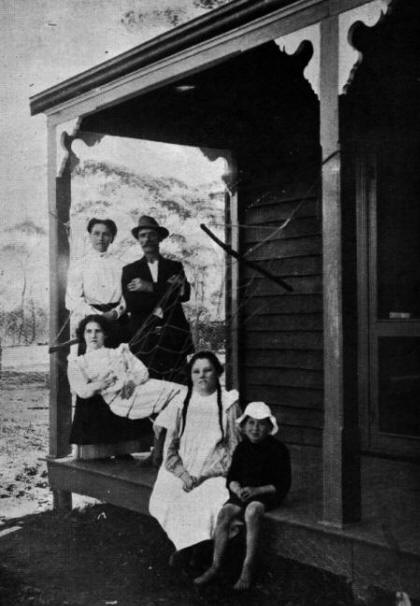
Philip and Eva Farley with three of their children
on their Ready-Made Farm in Coorow
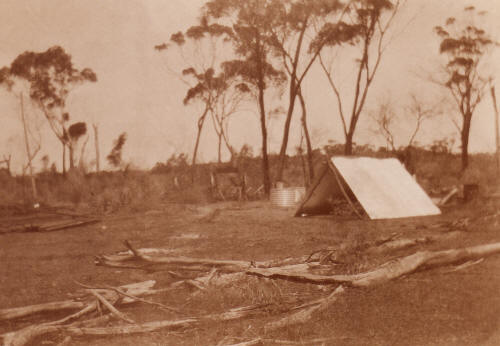
The beginning of Jones' Berkley Farm in Waddy Forest
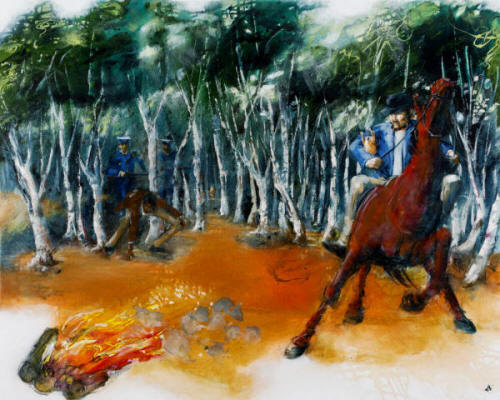
Local bushranger Frank Thomas
depicted in artwork Take Away (Chicken) by Di Taylor
from the exhibition 10863 Bushranger

German immigrant Gus Liebe
who established the enormous Waddi Farm
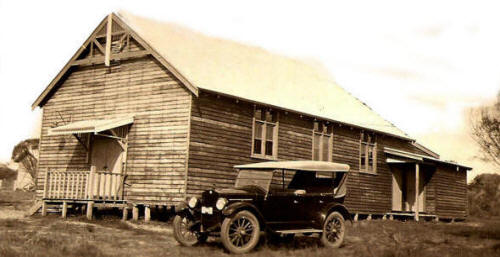
Bothe Bros' Essex car with MI ● 20 number plate
outside the recently built Agricultural Hall in Coorow
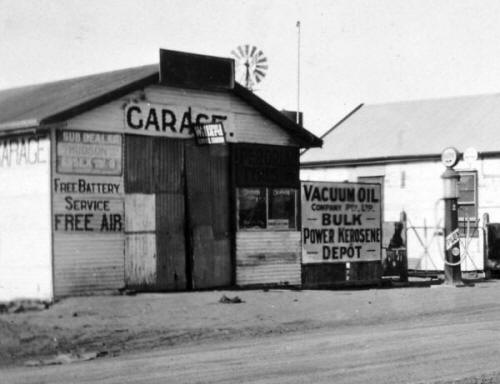
Garage built on Main Street in Coorow in 1928
for Bob Wells and initially occupied by Bruce Holden
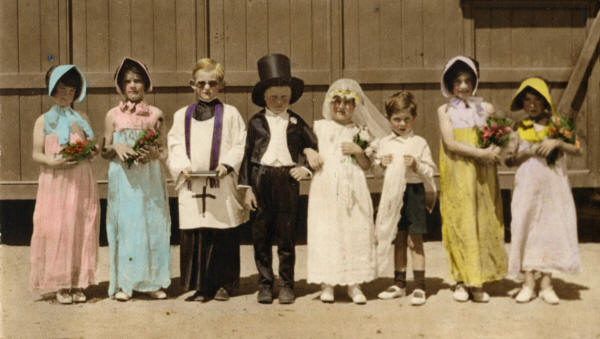
Colourised photo of children in Coorow in the 1930s



